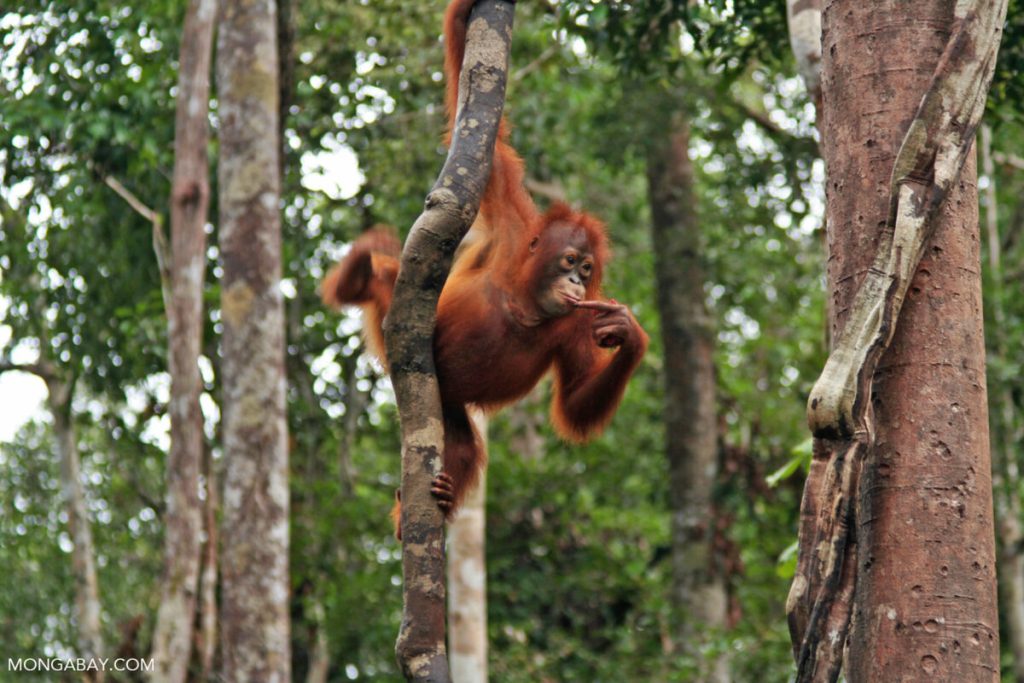- Worldwide, the most frequent causes of disturbances to ape habitats are land conversion for agriculture or logging, a recent study concludes.
- The study found that the most common ways apes adapted to habitat change included foraging for human crops, changing nesting patterns, and traveling along human-made paths.
- These changes can help apes survive in the short term, but can increase long-term risk, especially when behaviors like crop foraging bring them into conflict with humans.
- While some patterns were observed worldwide, human responses to behaviors like crop foraging varied widely, highlighting the need for local voices and priorities to be a central part of conservation planning.
Human activities such as mining, agriculture, urbanization, damming and logging threaten the habitats of great apes in Africa and Asia.
Apes have shown resilience to these disruptions by adapting their behavior in a variety of ways, including crop raiding and changing nesting sites, a new study finds. But while such adjustments appear to facilitate their short-term survival, they can make apes vulnerable to more dangers in the long term.
“Under many contexts changing great ape behavior is putting a strain on the human-ape relationship, resulting in injury, harassment and even the killing of apes,” reads the study, a global review of studies on apes’ adaptations to human-caused disturbances.
Since great apes are both behaviorally flexible and among the most threatened species on the planet, identifying patterns in their responses to human-generated disturbances can help categorize common concerns and long-term outcomes, the researchers say.
Co-author Miranda Gilbert, from the Great Ape Behaviour (GAB) Laboratory at the University of Victoria in Canada, told Mongabay that since human activities are increasingly affecting ecosystems, it’s important to understand how wildlife cope with such changes.
This, she said, helps us determine whether certain species can survive such changes in the long term, as well as understand any additional impacts animals may experience due to behaviors they adopt in order to survive in the altered environment, or because they decide to move to new habitats. Together, these help generate effective conservation strategies.
In this study, Gilbert and co-author Ammie Kalan, head of the GAB Lab, conducted a systematic analysis of existing studies on the behaviors wild great apes exhibit in response to anthropogenic habitat interference, and the outcomes of those behaviors.
They assessed nearly 2,500 studies but ended up with a final data set of 96 that assessed the behavioral responses of all seven extant species of nonhuman great apes: chimpanzees (Pan troglodytes), Bornean orangutans (Pongo pygmaeus), Sumatran orangutans (Pongo abelii), Tapanuli orangutans (Pongo tapanuliensis), eastern gorillas (Gorilla beringei), western gorillas (Gorilla gorilla) and bonobos (Pan paniscus).

Globally, they found large-scale land-use conversions for croplands and logging to be the most frequent disruption to ape habitats. The apes’ most frequent behavioral responses were crop foraging; choosing different nesting locations or changing how often they reused a nest; or “road crossing” — using human-made paths for easy travel.
Changing nesting patterns, which can help apes prevent interactions with humans, wasn’t found to result in negative outcomes. According to the study, this is “an encouraging demonstration of rapid flexibility by apes.”
However, other adaptations were found to lead to negative consequences, including signs of stress, injury, and even death. These stemmed from behaviors like eating human crops or traveling along human-made paths, which result in conflict with humans.
The analysis found behaviors and consequences vary depending on species and location, Gilbert told Mongabay in an email.
For example, in some cases, gorillas avoided logged forest almost entirely; in other cases, they would visit specifically to take advantage of the vegetation that developed in the wake of the logging.
Crop-foraging orangutans were found to experience less reaction from farmers in places where other animals pose higher threats to crops, but their large body size can still cause fear in people. Among chimps, in some areas where the apes forage on crops considered not commercially valuable, they’re not viewed as pests, while in other places they’re feared — even chased, trapped or killed.
“These patterns highlight the importance of tailoring conservation goals to fit local contexts; behavior changes exhibited by great apes seem to be either tools in their arsenal for surviving sudden environmental change or put them in even risker situations,” Gilbert said.
Strategies on land use need to appreciate the diversity of human-wildlife relationships, she said. She also recommended considering movement patterns, ecological corridors, and apes’ use of resources in conservation planning.

No room for complacency
“The ability of apes to adapt to anthropogenic pressure does not justify further degradation of their habitat, nor can all of their responses be interpreted as signs of their ability to successfully withstand change in the long term,” the study authors warn.
They call on conservationists and policymakers to be strategic in managing protected areas, “as we see that apes within and nearby these areas are still exposed to high levels of disturbance.”
“Given how much local attitudes impact great apes in anthropogenic habitats, it is critical that communities are not only consulted but are also part of the entire process involved from developing to enacting conservation strategies,” Gilbert said. “This ensures that plans are tailored to the local contexts in which humans and apes share habitats.”
Rachel Ikemeh, co-vice chair for Africa at the Primate Specialist Group of the IUCN, the global wildlife conservation authority, said that through documenting specific behavioral responses of apes to industrial land-use conversion, the study offers valuable insights into the direct and indirect consequences of habitat disruption.
“Understanding these adaptive behaviors is essential for developing effective conservation plans that mitigate the risks posed by anthropogenic pressures,” she said.
Ikemeh, who wasn’t involved in the study, ruled out the possibility of achieving primate conservation and industrial scale operations simultaneously within the same landscape and over the long term.
“While there are methods to integrate conservation efforts with economic growth, large-scale industrial land conversion is not one of them,” said Ikemeh, who’s also the founder and executive director of the South West Niger Delta Forest Project, a conservation initiative in Nigeria.
She said sustainable land-use methods may not be always be attractive to people who support industrial expansion, because such practices aren’t seen as yielding measurable profits.
“Therefore, stakeholders still face hard choices about prioritization,” she said. “However, prioritizing great ape conservation by preserving their habitats brings other quantifiable value-added benefits such as mitigating climate change, sustaining local livelihoods, and preserving sociocultural norms, among others.”
According to Ikemeh, balancing global human needs with the protection of great apes requires a combination of community engagement, innovative conservation strategies such as wildlife corridors, and sustainable land-use practices.
Banner image: A young orangutan grasps and hangs on to a woody liana. Image by Rhett A. Butler/Mongabay.
For Africa’s great apes, even ‘best-case’ climate change will decimate habitat
Citation:
Gilbert, M. A., & Kalan, A. K. (2025). A review of great ape behavioural responses and their outcomes to anthropogenic landscapes. Primates, 66(2), 163-181. doi:10.1007/s10329-025-01180-w
FEEDBACK: Use this form to send a message to the author of this post. If you want to post a public comment, you can do that at the bottom of the page.








